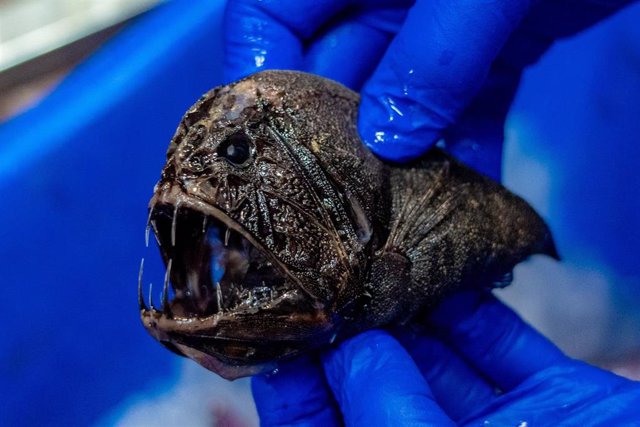Abyssal fish Anoplogaster collected in the investigation – CSIRO
Nov. 3 () –
An “amazing amount” of potentially new species have been found in the first inspection of life in deep waters in the Cocos (Keeling) Islands, in the Australian Indian Ocean.
Scientists led by the Research Institute of Museums Victoria have mapped in detail for the first time andhe recently protected seabed in the areafurther revealing huge, flat-topped ancient seamounts flanked by volcanic cones, interlocking ridges, and canyons formed by avalanches of sand that have collapsed to the bottom of the abyssal ocean.
The research vessel (RV) Investigator, operated by CSIRO, Australia’s national science agency, surveyed previously unknown deep-sea life in the Indian Ocean Territories. On a journey of 35 days and 1,000 km, an underwater video has revealed a diverse life of fish floating on the tops of seamounts, of which samples have been collected at a depth of up to 5 kilometers below the surface.
Some of the most fascinating finds are:
– A previously unknown blind eel collected at a depth of about 5 km covered with gelatinous, transparent and loose skin. Their eyes are poorly developed and, unusually for a fish, females give birth to live young.
– deep sea batfish that roam the seabed with their arm-shaped fins. They have a small “fishing lure” in a small hole in their snout to attract prey.
– The bathypterois guentheriwith incredibly long lower fins with thick tips, which allow it to rise from the bottom as if on stilts, giving it the perfect height to feed on the small shrimp that float in the current.
– The strange pelican eel with a tiny head at the front of its huge jaws and an expandable stomach so it can gobble up and swallow large foods. Pelican eels are covered in velvety black skin and have a light organ at the tip of their tail to attract prey.
– high fin lizard fish They are voracious deep-sea predators with mouths full of long, sharp teeth. They belong to a group of fish that are simultaneous hermaphrodites; they have an ovotestis with functional male and female reproductive tissue at the same time.
– The ravenous Chauliodus sloani, with huge fang-like teeth that are visible even when the mouth is closed. The viper fish has rows of light organs along the bottom and a very long upper fin with light organs at the tip to attract prey.
– The slender scissor eel, which is found at a depth of up to 4 km below the sea surface. With its long thread-like tail, can reach a meter in length with a weight of only 50 grams. The curved jaws, which are permanently open, are covered with tiny hooked teeth that latch onto crustacean prey.
– pancake sea urchins, They have a delicate skeleton that flattens like a pancake when out of the water. The spines are covered in poison.
– Pumice stones likely from the 1883 eruption of Krakatoa in Indonesia.
“We have discovered a staggering number of potentially new species living in this remote marine park,” he said. it’s a statement Dr Tim O’Hara, Expedition Lead Scientist from the Museum Victoria Research Institute.
The team has produced detailed three-dimensional images of the massive mountain below the Cocos (Keeling) Islands, that had never before been mapped in detail.
The dataset now covers a substantial area of the new marine park and shows the Cocos (Keeling) Islands as the twin peaks of a massive seamount. which rises almost 5,000 meters from the surrounding seafloor.














